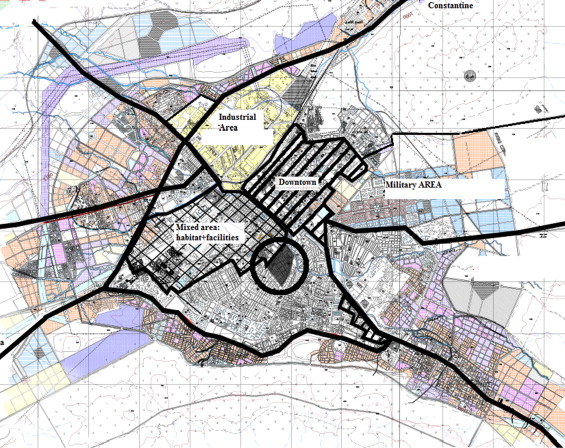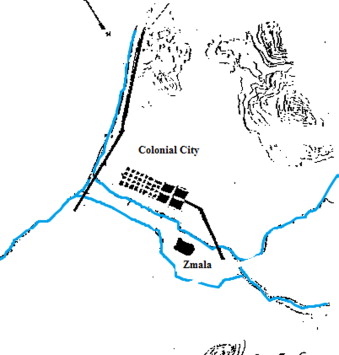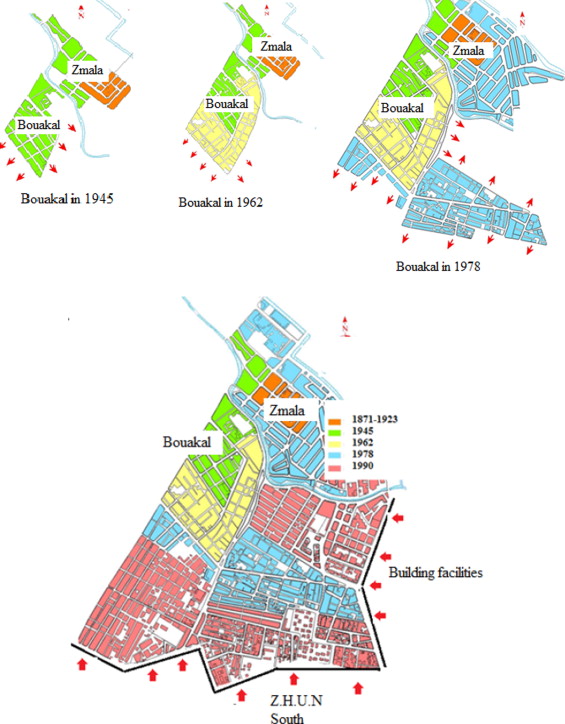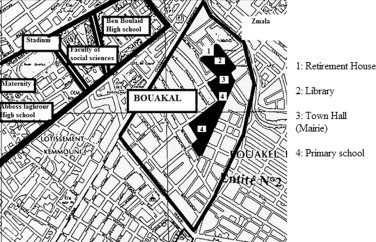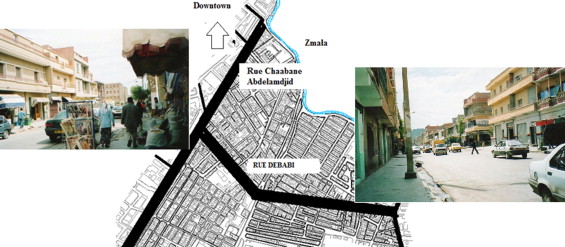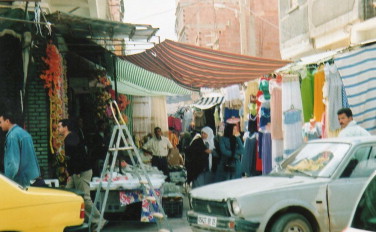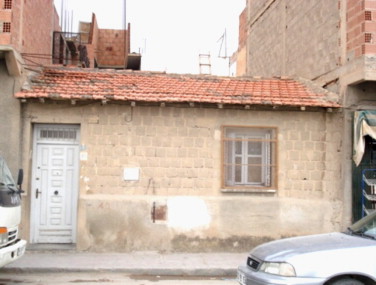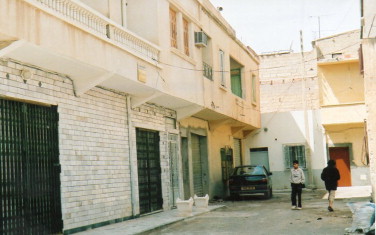Abstract
This paper explores how modifications of urban space in informal settlements influence residents′ quality of life and perceptions of safety. This is a case study of Bouakal, the oldest informal district in Batna, a middle city in Algeria.
This paper examines the effects of urban improvement practices in Bouakal by exploring two questions: In what ways did interventions in this informal settlement affect the quality of life for the residents? How do these effects correlate with changes in the perception of safety in this area? The survey involved 141 residents from Bouakal, and local residents were selected to collect the levels of perceived safety. This paper concludes that urban upgrading has improved the quality of life and has a positive effect on the perception of safety in the settlement.
Keywords
Informal settlements ; Safety perception ; Fear of crime ; Urban upgrading
1. Introdution
In Algeria, as in many developing countries the phenomenon of informal settlements is one of the considerable magnitude. Spontaneous sites emerged during the French colonization period. Built on the margin of the planned colonial city, they served as a shelter to underprivileged autochthonous populations. After gaining independence, the influx of rural migrants to cities and the resulting housing shortage propelled the explosion of spontaneous urbanization all over Algerian cities (Kebab, 1985 ; Benmati, 1991 ).
Today, this type of urbanization is an imposing urban reality. Currently, spontaneous areas constitute the most dominant form of Algerian urban landscape, and no city is safe (Hafiane, 1989 ; Deluz-Labruyere, 1982 ).
To deal with this problem, the Algerian government implemented improvement programs in urban slums in the mid-1980s. These programs were active in most Algerian cities. Originally, the programs upgraded elements of physical infrastructure including development of footpaths, drains, sanitation, and street lighting, which improved slum environments and health conditions of the poor and their quality of life.
The idea that informal settlements, like seedbeds in which “delinquents” carry on their activities has been sustained by traditional studies on violence (Clinard and Abbott, 1973 ). Previous Algerian studies have discussed how underdevelopment and bad physical conditions in urban slums can be related to high crime rates (Benatia, 1976 ; Bouanaka, 1987 ; Naceur, 2004 ).
Recent urban studies focused on the impact of improvement programs in spontaneous settlements (Al. Khalifa, 2011 ; Mohit, 2012 ; Farouk Hassan Ghada, 2012 ; Jota, 2011 ). However, little interest on the effects of these programs on the perception of safety among the occupants of these areas is noticed. The objective of this paper is to draw attention to this topic by focusing on the effects of urban improvement practices in the oldest informal settlement of Bouakal in the middle Algerian city of Batna.
2. Literature review
Worries over safety are a very prevalent issue that has gained momentum over the past years. Many people in today′s society express anxiety and fear about crime and about being victimized (DeFrances and Smith, 1998 ).
Studies have shown that the perception of safety is synonymous with fear of crime. Baba and Austin (1989) and Ferraro and LaGrange (1987: 72) defined fear of crime as “negative emotional reactions generated by crime or symbols associated with crime.” This definition considers both the emotional responses to situations that may produce fear, as well as the cognitive assessments of risk of victimization, which may also create fear.
Perception of safety and fear of crime have been the topics of considerable research efforts of late. Researchers realized that numerous other factors played a role in the fear of crime, and thus, research has turned to discovering what these factors are. Previous studies concentrated on individual factors that may significantly influence fear of crime. Three demographic variables—sex, age, and socioeconomic status—have been shown to influence attitudes on crime and safety (Skogan and Maxfield, 1981 ; Austin et al ., 1994 ).
Neighborhood context has also been considered among researchers who acknowledge that fear of crime and similar types of crime vary according to where individuals live. Researchers have focused on how perceptual measures of neighborhood conditions, in particular, neighborhood disorder relates to fear of crime.
It was the influential “Broken Windows” thesis (1982) that drew attention to the negative influence of deteriorating neighborhood conditions. Research has consistently demonstrated that deteriorating housing and neighborhood conditions increased concern about neighborhood safety (Skogan and Maxfield, 1981 ; Boorah and Carcach, 1997 ; Roché, 2002 ).The existence of neighborhood incivilities and other signs of deterioration might lead residents to believe that the level of social control in the area was deteriorating and spark concern and fear among residents (Skogan, 1990 , p. 3). Neighborhood residents who perceived their local surroundings as physically disorderly are more likely to exhibit higher levels of fear (LaGrange et al., 1992 ).
Planners and urban designers are beginning to consider the capacity of the built environment to reduce both the fear of crime and the potential for offending (Cozens, 2002 ). The high quality urban environment in Singapore contributes significantly to its relatively low crime rate and high urban safety (Yuen, 2004 ).
Regarding informal settlements, to date, there has been little research to examine the impact of improvement programs on perceptions of safety in these areas with few exceptions. Jota (2011) explored contemporary urban improvement practices in Latin America as a fundamental way that interventions in informal settlements can affect residents′ quality of life and perceptions of security. The study concludes that there is an apparent connection between physical structural changes to the urban form of informal settlements that these interventions create, and how residents in settlement communities are willing to express issues of security. Adding to this literature, the research presented here examines how modifications of urban space in Algerian informal settlements influences quality of life and perceptions of safety. This is a case study of Bouakal, the oldest informal district in Batna, a middle city in Algeria.
3. Methodology
The objective of the study is to examine the relationship between physical urban environment upgrading and residents′ perception of safety in Bouakal. The paper starts with a longitudinal study of the urban development of the city to explain why and how Bouakal came to be physically segregated and perceived as the most violent district within the city. Data about population profiles and resident′s perception of security was largely collected through the questionnaire. First, respondents were interviewed about the actual rate of violence within their district. A series of items relating to the frequency of a variety of forms of violence in Bouakal was given to the respondents. They were also asked about the rate of aggression in the district.
Regarding perceptions of safety, respondents were initially asked for their perceptions on the overall state of security in their district. Then they were asked if their district was more or less secure than other districts In addition to the perception of the safety, the questionnaire was used to collect information about household incomes, satisfaction with the physical environment, and safety in the neighborhood. In-depth interviews focused on the following questions.
- How was Bouakal in the past?
- What changes in security happened over time in the area?
The questionnaire was designed to draw out information on the respondents′ views about the neighborhood. Housing samples were taken from 1472 housing units identified within the study area of Bouakal. Ten percent (10%) of the total housing units were selected from every street within the district. Consequently, 150 housing units were drawn for sampling from the neighborhood. Choosing the sample in this manner allowed all residents to be chosen randomly. Out of the150 questionnaires administered to heads-of-household who were the respondents, only 141 were subsequently retrieved for data analysis.
4. Site study
This section provides background information on Bouakal. It explains briefly its origins and evolution, and summarizes its characteristics. Bouakal is a residential neighborhood spread over 30 ha. Most of the dwellings are individual, one or two story constructions with access to electricity, safe water, and cooking gas. Walls are brick over reinforced concrete. Because of these physical features, Bouakal can be considered an illegal or informal settlement but not a slum, especially because the majority of the area was developed in contradiction to planning regulations. It is one of the oldest districts of Batna. Compared to the other spontaneous districts in Batna, it is the most privileged because it is situated near the downtown Figure 1.
|
|
|
Figure 1. Location of Bouakal. |
4.1. Bouakal: origins and evolution
During the colonization, Batna, was organized in two distinct areas separated by a natural physical barrier “the wadi.” Zmala, the first Arabian core was created in 1923. In 1940, Bouakal evolved on lands adjacent to Zmala, following its anarchical extension (Figure 2 ; Figure 3 ; CADAT, 1974 ).
|
|
|
Figure 2. Batna in 1923: Two distinct areas. Source : CADAT, 1974 . |
|
|
|
Figure 3. Bouakal: origins and evolution. Source : PDAU 1994. |
There are two reasons for the growth of informal settlements in Batna after the country gained its independence: rapid urbanization over the past five decades and the influx of rural migrants (ANAT, 1994 ).
The city has experienced rapid urbanization over the past five decades. In 1977, the population was about 108,700. By 1987, population had increased to 184,069; and by 1998, it had increased further to 247,520 (POS, 2008). Commensurate with the increase in population of the city, informal settlements have also grown very fast. Second, a regular influx of rural migrants into the city contributed to the densification of these areas. Most of the migrants were attracted to Bouakal, the central and ancient informal district where they rented and shared flats or rooms at lower prices. The weak slope of the lands on the South encouraged the spectacular extension of Bouakal. People turned agricultural land into barren land; and then sold the sites to others as construction land (Figure 3 ). The government did not follow up with infrastructural services, which reinforced the process of social, spatial, and physical segregation of Bouakal from the rest of the city.
4.2. How Bouakal was perceived in the past?
Zmala, the first informal district in Batna, was an ideal community for marginalized people and especially prostitutes. The emergence of Bouakal, near Zmala allowed the propagation of social vices through the district. Drug dealers, prostitutes, and their clients moved to Bouakal and used the area as cover for their disreputable activities.
For many years, Bouakal was perceived as disreputable and too dangerous, a place to buy drugs and solicit prostitutes. The bad reputation of the district rebounds on its occupants affecting them negatively and thus, discouraging the accessibility of strangers for numerous years. Several respondents commented on the negative image of marginalized people, crime, and violence that has been associated with the area in the past. A few said that they knew of residents who wanted to move out of Bouakal not because of any concerns about personal safety, but because they were uncomfortable about the negative image of the place.
As with many other informal districts, Bouakal was isolated from the main city and more importantly, from the main institutions of the state. This isolation provides an environment that favors informal activities, deviant behavior, and the emergence of violence. For decades, the state police considered this area dangerous. Violence in Bouakal was higher than in the rest of the city (Aichour, 1992 ). During the 1990s, because of the terrorism that affected the country, Bouakal turned into a fiefdom for terrorists and a shelter for outlaws.
4.3. Improvement programs in Bouakal
Several actions have been conducted to upgrade Bouakal. Residential neighborhoods have experienced several initiatives for improving the living conditions of its dwellers. Most noticeable of these initiatives is the “P.U.D 1985” (Planned Urban Development) program, with the goal to provide the neighborhood with basic urban services including clean water, improved sanitation, electricity, and paved roads (ANAT, 1989 ).
The urban facilities built on the West fringe of the district contributed to limiting its anarchical extension in this direction. Figure 4 shows the location of these facilities that include: two high schools, a maternity clinic, a stadium, and a school for social sciences. This set of administrative facilities built all along the western urban artery form the urban façade of Bouakal. The limits of the infrastructure of these projects became the border with the city. Many services were initiated for the improvement of the neighborhood. It was decided to use the free lands inside the district for construction of several public buildings: a retirement house, a library, two elementary schools, and a town hall. The resulting changes provide a better image and status for Bouakal.
|
|
|
Figure 4. Facilities: location and type. |
Neighborhood improvement programs executed by the municipality of Batna in 1985 aimed to integrate the spontaneous districts into the formal fabric of the city through two actions:
- Completion of basic urban infrastructure like water, sewer, electricity, and waste disposal.
- Physical urban reconfiguration of the district through platting new street grids.
To achieve this goal, an existing street, the “rue DEBABI” was selected to be the spine of the district accessible to both pedestrian and vehicle transportation. The Debabi corridor, thanks to its regular tracing, clarity, and width, acquired a public character and turned into a greatly frequented corridor. The emergence of commercial activities on the lower floors of the dwellings in the area has created a true urban dynamic along this corridor. Another main street at the border was used to connect the interior of the district to a network of streets on the outside in the city. The west border of Bouakal has been clearly defined by a major artery that links it with the downtown. The Rue Chaabane Ablemadjid became the preferred armature along which other main public buildings have been sited Figure 5 . This dynamic artery became a mixed-use residential and commercial street. All other streets were paved. Houses located in the path of new roads were removed and their inhabitants relocated to new housing projects where new lighting was added to improve visibility and to extend the use of the walks into the evening.
|
|
|
Figure 5. Physical urban reconfiguration: clarity and regular tracing. |
4.3.1. Commercial dynamism
After these interventions, a very strong commercial dynamism emerged particularly along an interior street, the Rue H. This street turned into a commercial trade route specializing in women and children′s clothing, shoes, cloths, furnishing, kitchen utensils, etc. There are about 194 boutiques on H Street Photo 1 . This commercial dynamism broke down the barriers that have long divided Bouakal from the rest of the city, ultimately enabling people who have never before entered it to drive through the settlement and make use of its commerce (Saidi,1999 ).
Photo 1.
Attractiveness of La rue “H”.
The attractiveness of la rue H permitted the influx of people not only from outside of the district but from the surrounding cities too. It is clear from interviewees′ accounts that commercial attractiveness plays an important role in improving the everyday life of communities. The increase in mobility of community members and foreigners are constantly mentioned in interviews as a sign that conditions today are much better than they were before.
5. Research results
5.1. Impact of infrastructure improvements on residents′ economic situations
To what extent have these infrastructure improvements increased economic gains and reduced poverty levels in this community? In order to answer this question, two sources of information were used: household income and home improvements. To get the approximate household incomes, three indicators were used: occupation of the head-of-household, quality of the location of the house (number of stores, etc.), and sources of wealth (possession of cars, trades, etc.). Households were grouped into these three categories: low, middle, and high incomes.
The characteristics of residents as shown in Table 1 indicate that more than half (66%) of the households had a middle income. Thus, the residents of the study area represent middle class socio-economic levels in Batna. These results show a significant improvement in the socioeconomic status of the inhabitants of Bouakal who were perceived as largely deprived. This is partly due to the commercial dynamism in the 1980s.
| Low income | Middle income | High income | Total | |
|---|---|---|---|---|
| Number | 40 | 93 | 08 | 141 |
| Valid (%) | 28.4 | 66 | 5.6 | 100 |
Local economic activity intensified in the 1980s partly because of, and not despite, the country′s debt crisis linked to the economic downturn. As a consequence, increasing numbers of people in Bouakal have turned to street commerce in this well-situated area.
In the beginning, customers came from other low-income urban neighborhoods looking for items generally sold for less than in outlying districts. Over the years, even the rich have come to this area, which for decades they dared not enter, in search of bargain-priced designer clothing and high-tech equipment. To take advantage of this commercial dynamism, most residents have transformed garages overlooking main streets into commercial premises. Over the years, the area has become a flourishing center of contraband trade. This important additional source of income induced a real improvement in the economic situation of the local residents. The impact of this improvement is perceptible also in the quality of housing. Observations show that many residents improved their units. More floors were added to existing structures and most dwellings underwent renovations. This led to the total disappearance of the traditional type of housing Photo 2 . Tile houses have been replaced by one and two story apartment buildings. The number of floors, the quality of the construction materials, the finish, all of these factors confirm the improvement of the economic situation of the occupants Photo 3 .
Photo 2.
Traditional type of housing.
Photo 3.
New type of housing.
5.2. What changes in security happened over time in the area?
Results of informal interviews with older residents showed that Bouakal was perceived as disreputable and too dangerous for many years. To examine whether changes in security happened over time in the area, a questionnaire survey was conducted. Respondents were interviewed about:
- the actual rate of crime within their district,
- their perceptions of the overall state of security in their district, and
- the real rate of aggression in the district.
5.2.1. The actual rate of crime within the district
Respondents were first asked to rate crime in their area as either: a very big problem, a moderate problem, or not a problem.
Results of the investigation revealed that crime is not seen as a significant problem in Bouakal. The main crime problem mentioned was shoplifting on rue H. Results on the rate of crime in the district confirmed this opinion. The rate of conflicts proved to be moderate. Only 20.6% of respondents in Bouakal think that conflicts are frequent in their district. 85.8% said that there is no use of weapons in their district.
The rate of larcenies and burglaries was lower than predicted. Of the respondents, said that the rate of larcenies is low in the neighborhood Table 2 .
| Number | Valid (%) | Cumulative (%) | |
|---|---|---|---|
| Is crime in your area? | |||
| a very big problem | 6 | 4.3 | 4.3 |
| a moderate problem | 37 | 26.2 | 30.5 |
| not a problem. | 98 | 69.5 | 100 |
| Frequency of conflicts | |||
| Often | 29 | 20.6 | 20.6 |
| Seldom | 62 | 44.0 | 64.6 |
| Never | 50 | 35.4 | 100 |
| Frequency of use of weapons | |||
| Often | 09 | 06.4 | 06.4 |
| Seldom | 11 | 07.8 | 14.2 |
| Never | 121 | 85.8 | 100 |
| Rate of burglaries or robberie | |||
| High | 18 | 12.8 | 12.8 |
| Average | 20 | 14.2 | 27.0 |
| Low | 103 | 73.0 | 100 |
| Rate of larceny thefts | |||
| High | 10 | 7.1 | 7.1 |
| Average | 15 | 10.6 | 17.7 |
| Low | 116 | 82.3 | 100 |
| Drug abuse | |||
| High | 15 | 10.6 | 10.6 |
| Average | 36 | 25.5 | 36.2 |
| Low | 90 | 63.8 | 100 |
| Existence of places of prostitution in the district | |||
| No | 136 | 96.4 | 96.4 |
| Yes | 05 | 3.6 | 100 |
Interviews with older residents revealed that drugs, prostitution, and violence were all found to be less of a problem than in earlier years. Criminal activity has been clearly discouraged.
5.2.2. Levels of perceived safety
To measure perception of safety in one′s neighborhood, respondents were asked to reply to the following statements:
- People who live in this neighborhood have to worry about someone breaking into their home to steal things.
- People in this neighborhood can walk around without fear of being attacked or bothered.
These questions were used in past research when respondents were asked to compare safety within their district to other districts in the city (Baba and Austin, 1989 ).
Results of this survey showed that almost all the respondents considered their community to be a safe place to live. Most of those surveyed felt secure, with 92.2% reporting that people in Bouakal can walk around without fear of being attacked or bothered. Only 11.3% said that people who live in Bouakal have to worry about someone breaking into their home to steal things, while 78% perceived Bouakal to be safer than most other districts Table 3 .
| Number | Valid (%) | Cumulative (%) | |
|---|---|---|---|
| People who live in this neighborhood have to worry about someone breaking into their homes to steal things. | |||
| Yes | 16 | 11.3 | 11.3 |
| No | 125 | 88.7 | 100 |
| People in this neighborhood can walk around without fear of being attacked or bothered. | |||
| Yes | 130 | 92.2 | 92.2 |
| No | 11 | 7.8 | 100 |
| Is Bouakal safer than other districts? | |||
| Yes | 110 | 78 | 78 |
| No | 31 | 22 | 100 |
Nevertheless, there is a perception of insecurity within the Bouakal district that is felt more by the shop owners. Many owners affirmed during our interviews that the only recourse is to post a guard during the night in the garages to prevent burglaries.
5.2.3. The real rate of aggression in the district
In addition to the levels of perceived safety, respondents were asked about the real rate of aggression in the district. The rate of aggression was measured from responses to two questions: (1) have you or anyone you know in this neighborhood ever had their home broken into and/or had something stolen? and (2) have you or anyone you know ever been attacked, mugged, or robbed while out walking in the neighborhood?
The findings of the survey reveal that the rate of those who had been attacked personally in the district is relatively low. Of the respondents, only 2.1% had experienced an aggression in their district Table 4 .
| Number | Valid (%) | Cumulative (%) | |
|---|---|---|---|
| Have you or any one you know in this neighborhood ever had their home broken into and/or had something stolen? | |||
| Yes | 04 | 2.8 | 2.8 |
| No | 137 | 97.2 | 100 |
| Have you or anyone you know ever been attacked, mugged, or robbed while out walking in the neighborhood? | |||
| Yes | 03 | 2.1 | 2.1 |
| No | 138 | 97.9 | 100 |
5.2.4. Satisfaction within the neighborhood
To measure satisfaction with the physical environment, respondents were asked to use a three point Likert scale ranging from very satisfied to dissatisfied to indicate how satisfied they were with the: (1) physical environment of the district and (2) safety in the neighborhood.
High scores represent higher levels of satisfaction.
As evident from Table 5 , residents expressed high levels of satisfaction with the physical environment of their district and safety in their neighborhood. Of the respondents, 85.1% felt satisfied or very satisfied with the physical environment and 89.4% felt satisfied or very satisfied with safety. In-depth interviews with older residents confirmed these results. They point out that present living conditions of the neighborhood are better today than they were before the interventions. Most of them narrate how changes in the provision of appropriate sewer, water, and the paving and creation of new roads contributed significantly to the improvement of their communities.
| Number | Valid (%) | Cumulative (%) | |
|---|---|---|---|
| Satisfaction with physical environment | |||
| Dissatisfied | 21 | 14.9 | 14.9 |
| Satisfied | 51 | 36.2 | 51.1 |
| Very satisfied | 69 | 48.9 | 100 |
| Satisfaction with safety | |||
| Dissatisfied | 15 | 10.6 | 10.6 |
| Satisfied | 62 | 44.0 | 54.6 |
| Very Satisfied | 64 | 45.4 | 100 |
6. Conclusions
Results show that beyond the sanitary conditions and esthetic values, the physical interventions in Bouakal induced many positive impacts on the quality of life for the residents. The image of the district has improved. Housing refurbishment improved not only spatial conditions but also additional personal and esthetic elements. Commercial attractiveness within the district brings more people to the districts and has reduced the poverty levels in this community.
The resulting changes provide a better image for Bouakal and increase the mobility through the district, which in turn discourages criminal activity. Many changes in security happened over time in the area. Results of the investigation reveal that crime is not seen as a significant problem in Bouakal. Respondents said that there is little serious crime in their area. They tend not to consider crime and safety to be major issues in their lives, and few have personally experienced crime. Drugs, prostitution, and violence were all found to be less of a problem than in earlier years. Clearly, criminal activity has been discouraged and the overall crime rate in the development has dropped. Bouakal, which was perceived as disreputable and too dangerous for a number of years, is becoming a pleasant place to live and a safe neighborhood. The majority of its residents feel safe. Most of the residents asked to compare safety in their district to safety in other districts say that Bouakal is safer than the other districts.
In addition to the improvement in safety, residents express high levels of satisfaction with both the physical environment and safety in the neighborhood.
The research concludes that physical interventions in this informal settlement have had positive impacts on both the quality of life of the residents and on overall perceptions of safety. The main hypothesis of the present study that urban improvement in Bouakal improved the quality of life of residents and their perceptions of safety in the area are clearly confirmed.
The present study confirms past research that found a positive relationship between neighborhood quality, satisfaction with the local physical environment, and perceptions of safety. More importantly, the results corroborate findings of previous research on spontaneous settlements that found improving neighborhood conditions had a positive influence on perceptions of safety (Jota, 2011 ). These results are in accord with findings of previous research that high quality urban environments contribute to urban safety and relatively low rates of violence.
References
- ANAT, 1989 ANAT, 1989. PAW Plan d′aménagement de la wilaya.
- ANAT: Avril, 1994 ANAT: Avril, 1994. Plan directeur d′aménagement et d′urbanisme phase 1 Bilan et perspective du développement⪡PDAU.
- Al. Khalifa, 2011 M. Al. Khalifa; Redefining Slums in Egypt: Unplanned versus Unsafe Areas; Habitat International, 35 (2011), pp. 40–49
- Aichour, 1992 Aichour, B., 1992. Les effets pervers de la mauvaise qualité d′habitat cas de cites urbaines dans les Aurés-Algérie. Revue de l′université de Constantine N° 3 Juin.
- Austin et al., 1994 D.M. Austin, C. Woolever, Y. Baba; Crime and safety-related concerns in a small community; American Journal of Criminal Justice, 19 (1994), pp. 79–97
- Baba and Austin, 1989 Y. Baba, D.M. Austin; Neighborhood environmental satisfaction, victimization, and social participation as determinants of perceived neighborhood safety; Environment and Behavior, 21 (1989), pp. 763–780
- Benatia, 1976 F. Benatia; Du sous développement au développement urbain; Les bidonvilles d′Alger. Etude ronéotée; APC Alger (1976)
- Benmati, 1991 N. Benmati; Analyse de l′évolution des processus de production de l′espace de l′habitat informel; Thèse de magister (1991), p. pp.162
- Boorah and Carcach, 1997 V.K. Boorah, C.A. Carcach; Crime and fear; British Journal of Criminology, 37 (1997), pp. 635–657
- Bouanaka, 1987 A. Bouanaka; Les quartiers sponatnés et leur répercutions sur les jeunes, Alger; Presses Universitaires (1987), pp. 19–20
- CADAT, 1974 CADAT, 1974. Plan d′urbanisme. Phase B: Etat de fait Bilan.
- Clinard and Abbott, 1973 M.B. Clinard, D. Abbott; Crime in Developing Countries: A Comparative Perspective; John Wiley & Sons, New York (1973), pp. 365–370
- Cozens, 2002 P.M. Cozens; Sustainable urban development and crime prevention through environmental design for the British city. Towards an Effective urban environmentalism for the 21st century; Cities, 19 (2) (2002), pp. 129–137
- DeFrances et al., April 1998 DeFrances, C.J., Smith, S.K. (1998, April). Perceptions of Neighborhood Crime, 1995. Bureau of Justice Statistics, Special Report. April 1998.
- Deluz-Labruyere, 1982 J. Deluz-Labruyere; Urbanisation en Algérie-Blida, processus et formes d′urbanisation; Ed OPU (1982), p. 34.2
- Farouk Hassan Ghada, 2012 Farouk Hassan Ghada; Regeneration as an approach for the development of informal settlements in cairo metropolitan; Alexandria Engineering Journal, 51 (2012), pp. 229–239
- Ferraro and LaGrange, 1987 K. Ferraro, R. LaGrange; The measurement of fear of crime; Sociological Inquiry, 57 (1987), pp. 70–101
- Hafiane, 1989 A. Hafiane (Ed.), Les défis à l′urbanisme, Ed OPU (1989) , pp. 290
- Jota, 2011 Jota S., 2011. Urban Regeneration in a Context of Violence: The Case of the Favela-Bairro in Rio de Janeiro. Available from: 〈http://informalsettlements.blogspot.com/2011/06〉 .
- Kebab, 1985 A. Kebab; L′habitat privé populaire- le cas de Souk-Ahras; Thèse de Magister (1985), p. pp. 328
- LaGrange et al., 1992 R. LaGrange, K. Ferraro, M. Supancic; Perceived risk and fear of crime: role of social and physical incivilities; Journal of Research in Crime and Delinquency, 29 (1992), pp. 311–334
- Mohit, 2012 A.M. Mohit; Bastee settlements of Dhaka City, Bangladesh: a review of policy approaches and challenges ahead; Procedia Social and Behavioral Sciences, 36 (2012), pp. 611–622
- Naceur, 2004 F. Naceur; ‘L′environnement urbain et les malaises dans les quartiers d′habitat spontanés′ These de doctorat d′état, option urbanisme; Université de Constantine (2004)
- Roché, 2002 S. Roché; Tolérance Zéro incivilités et insécurité; Editions Odile Jacob (2002)
- Saidi, 1999 T. Saidi; Quartier informel et nouvelle centralité: Cas de Bouakal. Batna. Algérie′: mémoire en vue de l′obtention d′un Magister; Université de Constantine (1999)
- Skogan and Maxfield, 1981 W.G. Skogan, M.G. Maxfield; Coping with Crime; Sage, Newbury Park, CA (1981)
- Skogan, 1990 W.G. Skogan; Disorder and Decline. Crime and the Spiral of Decay in American Neighborhoods; Free Press, New York (1990)
- Yuen, 2004 B. Yuen; Safety and dwelling in Singapore; Cities, 21 (1) (2004), pp. 19–28
Document information
Published on 12/05/17
Submitted on 12/05/17
Licence: Other
Share this document
Keywords
claim authorship
Are you one of the authors of this document?
